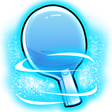Recommended sponge thickness and hardness combination
Equipment
Stephen Gerada Asked 12 years ago
Hi Coaches!
I am asking if what is the most recommended sponge thickness combination on your forehand and backhand. Example: If i use a 2.2mm sponge on my forehand, how thick should be my backhand sponge?
Also, is hard sponged rubber not recommended for serves?
Thanks a bunch!
Stephen
 Alois Rosario Answered 12 years ago
Alois Rosario Answered 12 years ago
Hi Stephen,
Your backhand sponge thickness depends on how good your backhand is and what you want to do with it. If you are particularly offensive on the backhand then you could use 2.2 there as well.
You can play with hard sponge for serving if the top sheet is grippy. You will still get good spin.
Thoughts on this question
Become a free member to post a comment about this question.
Stephen Gerada Posted 12 years ago
If I use 2.2 on both backhand and forehand, wouldn't it be too heavy? And would I have difficulty in using it?
(I am a dominantly an offensive player and loves doing forehand loops, but i also wanted to develop my backhand into a powerful weapon)
Once again , thank you so much,,your responses are very very helpful.
Stephen
If you are developing your backhand at the moment then go for 2mm. It is not too difficult to use 2.2 on both sides. You will soon get used to the weight.
Stephen Gerada Posted 12 years ago
ok,,thank you so much
Really appreciate your quick response.
Cheers
Hendrik S Posted 9 years ago
Id like to add a question here:
Is it a problem in developing or even playin if u got a thicker sponge on the backhand than the forehand? Iv heard that it can causes some trouble with the technique but i see a lot of players using FH: 1,9 and BH: 2,1 , for example and in fact it was only a single opinion but im not sure mybe u know something about this.
What might fit in here as well is something else considering the learning and sponge thickness:
We know that thicker sponge are spinnier, so with max rubbers its easier to land loops if u got some technique. The curve makes it easier to land the ball on the table. So control is a difficult and very subjective term in table tennis anyway, as i had to learn. Atm im not sure if i should choose the 2.0 or max rubbers for my new blade, i was used to 1,8 before but i was surprised that my loops got also more controlled with a thicker sponge, which seems logical in the end, it might also be easier to lift backspin with a loop. The interesting thing here is that i can remember a coach who said that teaching the modern style of table tennis below 2.0 sponge, even fore beginners, doesnt make sense to him. At that time i lold, but yesterday i read that in China many players dont even know what max, 1.8 etc. means(cant imagine that but...), as they are all learning and training with max sponges, even the kids and beginners!(could imagine that, not that fast blades ofc). Kinda interesting and funny but also shows how complicated this sport is :D Mybe u can help me deciding between max and 2.0 rubber for the next blade, or even back to 1,8 on one side, quite confused atm :P Still want to improve the off strokes to perfection, but got something alrdy and a good hand for blocking as well(worked with max so far), problem might be developing the push (bigggest need), whereas u get punished harder for wrong pushes with max sponge and have a better feedback this way mybe... could be even an advantage for learning as the need for better technique is higher xD
What are your thoughts about this? Especially China and the aspect of more control with a thicker sponge in a modern spin based game, without considering someone touching the bat for the first time, but the development of intermediate and maybe also decent beginners.
martinand bernard Posted 9 years ago
an other articule says to use max it's interesting to test Ithink if we don't try we don't say
Hi Henrik,
Interesting thoughts about thicknesses. The thicker sponges are also faster so that is where the control factor some in. If you feel comfortable playing with the thicker sponge because of the spin and dip then you should stay with it. The speed of the actual type of rubber will always be a factor here.
Hendrik S Posted 9 years ago
Thanks for your response,
what do u think about this:
Is it a problem in developing or even playin if u got a thicker sponge on the backhand than the forehand? Iv heard that it can cause some trouble with the technique but i see a lot of players using FH: 1,9 and BH: 2,1 , for example and in fact it was only a single opinion but im not sure mybe u know something about this."
I know that most people use the thicker sponge on forehand, but i wonder if it works the other way around, or if theres any trouble/disadvantage with such a combination, even if the bh should be the stronger wing.
Hi Hendrik,
There is no reason that a player shouldn't use a thicker sponge on the backhand especially if the backhand is stronger than the forehand.